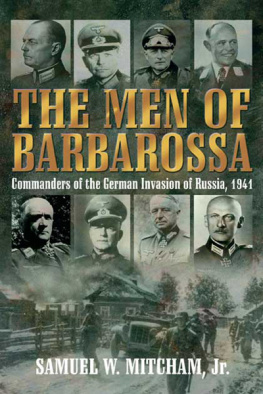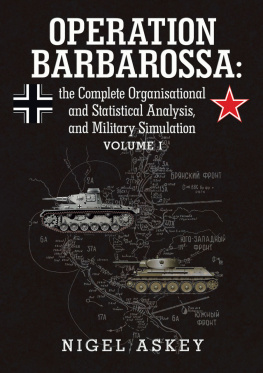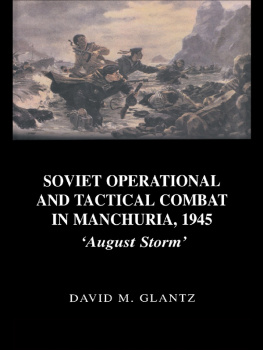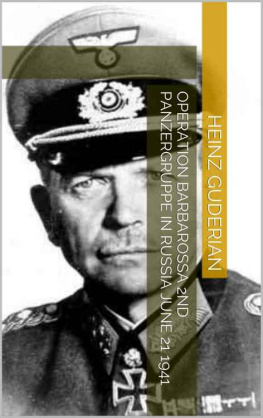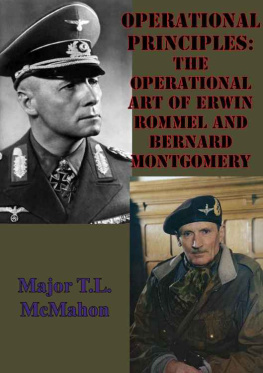This edition is published by PICKLE PARTNERS PUBLISHINGwww.picklepartnerspublishing.com
To join our mailing list for new titles or for issues with our books picklepublishing@gmail.com
Or on Facebook
Text originally published in 1994 under the same title.
Pickle Partners Publishing 2015, all rights reserved. No part of this publication may be reproduced, stored in a retrieval system or transmitted by any means, electrical, mechanical or otherwise without the written permission of the copyright holder.
Publishers Note
Although in most cases we have retained the Authors original spelling and grammar to authentically reproduce the work of the Author and the original intent of such material, some additional notes and clarifications have been added for the modern readers benefit.
We have also made every effort to include all maps and illustrations of the original edition the limitations of formatting do not allow of including larger maps, we will upload as many of these maps as possible.
OPERATIONAL LOGIC AMD IDENTIFYING SOVIET OPERATIONAL CENTERS OF GRAVITY DURING OPERATION BARBAROSSA, 1941
by
MAJ David J. Bongi, USA
ABSTRACT
This monograph examines Soviet operational centers of gravity during Operation Barbarossa, the German invasion of the Soviet Union in 1941. Specifically, the examination focuses in two areas: (1) German planning for Operation Barbarossa; (2) the operational objectives selected for the second phase of the campaign.
The second phase was selected because it was during this phase that the focus of the German military effort became diverse. Two competing strategies within the German political and military command structure caused this. While political-ideological and economic factors influenced one, purely military concerns influenced the other. In the end, the Germans diluted combat power in phase two towards three operational objectives: Moscow, Leningrad, and the Ukraine.
Thus, the research question for this monograph is: Which, if any, of the German operational objectives for the second phase of the campaign were also Soviet operational centers of gravity?
The analysis of operational objectives uses Colonel William Mendels and Colonel Lamar Tookes analytical model called Operational Logic: Selecting the Center of Gravity. Potential centers of gravity are analyzed using a validity and a feasibility test.
This monograph concludes that Moscow was the operational center of gravity for the campaign by virtue of its direct and intrinsic relationship to the strategic center of gravitythe Soviet Military.
I. INTRODUCTION
At 0330 on 22 June 1941, the German Army invaded the Soviet Union. Operation Barbarossa, the code name for the invasion, involved more than three million men, 3,350 tanks, and 7,134 artillery pieces. {1} With the war still unfinished in the West, Germany opened a second front, thus provoking a two front war which earlier German military strategists such as von Moltke and von Schlieffen had so ardently attempted to avoid during the Great War. In the end, the greatest land invasion force in the history of warfare reached its culminating point before it was able to attain its strategic aims.
Questions and issues concerning Operation Barbarossa still abound today, permeating all three levels of warstrategic, operational, and tactical. For example: Did the strategy of opening a two-front war eventually produce a defeat for Germany? Did the Germans follow a preconceived campaign plan or did they use something closer to ad hoc strategy? Was the failure in the East an inability to link the tactics with the strategy? Finally, one particular issue during the planning and execution of this campaign was the shifting of priorities at the highest levels of the German political and military command structure. In short, the influences of the political aims for this campaign often permeated down to the operational planning. This kind of influence caused operational commanders to divert forces needlessly, dilute combat power, and eventually culminate before they could achieve victory.
Operation Barbarossa offers many lessons to the student of operational art. While all three levels of war are each worthy of independent study and examination, this monograph focuses at the operational level. Specifically, the emphasis is in two areas: (1) the planning for Operation Barbarossa and (2) the operational objective selected for the second phase of the campaign.
Why the second phase? During the first phase, the Germans focused military power against the Russian Army. Arguably, the Russian Army was an appropriate operational objective. Their destruction meant the remainder of the campaign would be a mere exploitation. However, during the second phase, the German focus became diverse. Two competing strategies caused this diversity. One influenced by political-ideological and economic factors, the other predominately by military concerns. In the end, the focus for phase two essentially split three ways. For Hitler, the primary focus oriented towards Leningrad and then the Ukraine. The Army focused on Moscow.
This leads us to the research question for this monograph: Which, if any, of the German operational objectives for the second phase of the campaign were also Soviet operational centers of gravity? There is, of course, a distinction between the two. Operational objectives are not necessarily operational centers of gravity; however, the reverse is not trueoperational centers of gravity must be operational objectives. This research question is important because German operational objectives identified as Soviet operational centers of gravity could have, in theory, provided the necessary focus for German combat power during this phase of the campaign. After all, that is one of the values of the concept of center of gravity, it provides focus.
While this premise is theoretically possible, one should remember that many influences which transcend pure military necessities drove German strategy in this and other campaigns. This monograph briefly discusses these political, economic, and ideological influences, but an extensive examination is beyond the scope of this study. The purpose here is to examine operational centers of gravity and the military means of achieving them.
Fifty-three years since Operation Barbarossa, the concept of center of gravity remains an enigma. Arguably, no other operational concept offers more discussion and debate than the concept of center of gravity. It is a concept that flows through our doctrine from the strategic to the tactical levels of war. Joint doctrinal publications as well as the Armys FH 100-5 identify the concept of center of gravity as one of the key concepts of theater and operational design. {2}
However, while the definition and description of this concept is generally understood by operational-level planners. its application in the operational design of campaign planning is often difficult and, at times, confusing. Questions which often arise in the application of this concept are: How do we Know that we have selected the correct center of gravity? Is there more than one? Is there a center of gravity at each level of war? Is there more than one at each level? Is it something abstract such as national will, or something more concrete like the enemys armed forces. Does it ever change and if so, how will we know it has changed?





